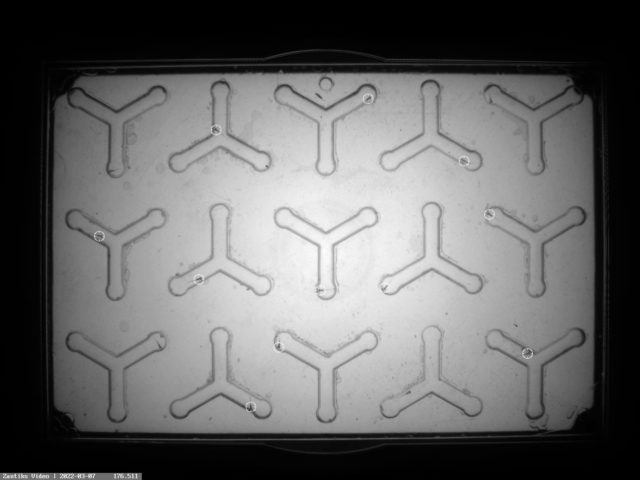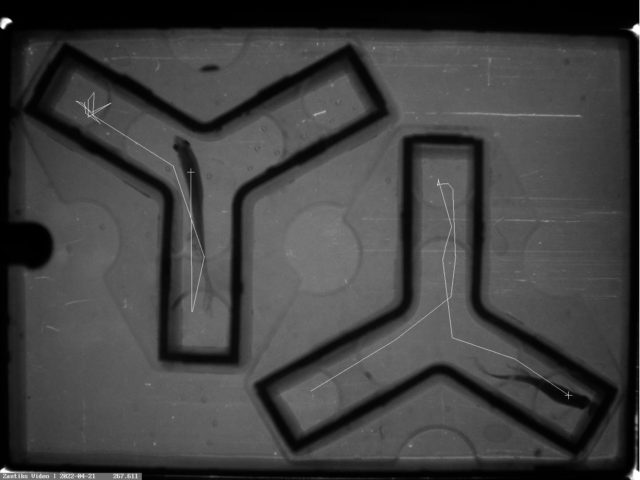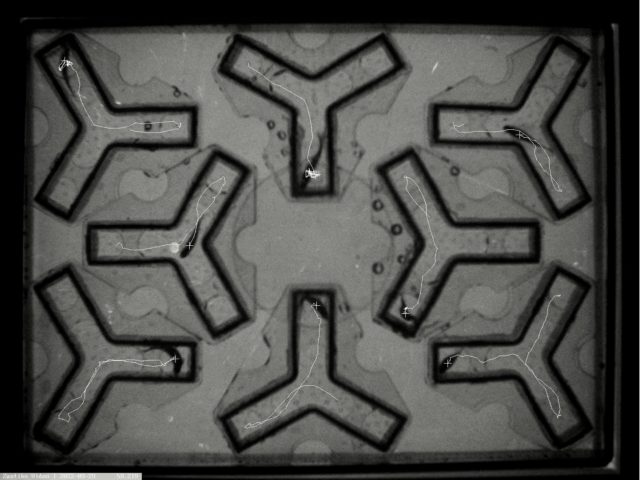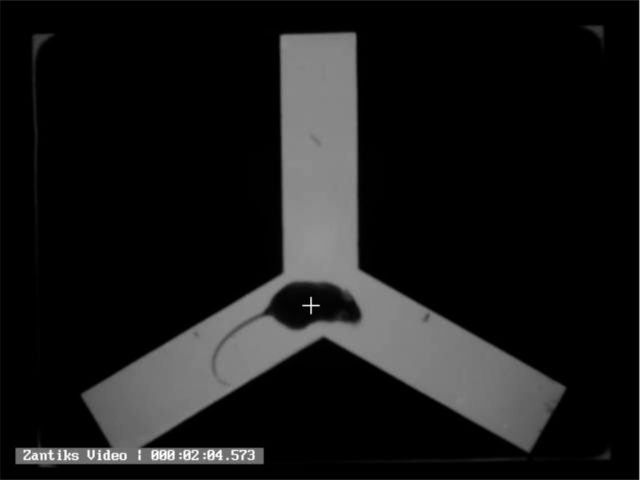This is an unconditioned behavioural test used to assess exploratory behaviour and spatial working memory function in rodents, fish and Drosophila.
Many assays, such as the T-maze and radial arm maze, require extensive training, high levels of animal handling and, reward-based trials, food or water deprivation for prolonged periods. Each of these factors can result in potential confounds, leading to high levels of between subject variability.
The Y-maze assay takes advantage of an animal’s natural exploration, but does not involve conditioned learning, providing a test that is quick with minimal training time.
One paradigm used in the Y-maze is the Spontaneous Alternation Test: a continuous Y-maze where animals are allowed to explore all arms freely. The sequence of arm entries is recorded and working memory is determined by the percentage of spontaneous alternations (i.e., entry into three different arms in succession).
Dr Matt Parker, University of Surrey, explains the benefits of using the Y-maze with zebrafish, which include not needing to individually house the fish individually before the test and that the task provides detailed information on cognitive processes quickly.
Experimental set up
Depending on your choice of animal model, any of the Zantiks systems (Zantiks MWP, Zantiks LT or Zantiks AD units) can be used for Y-maze testing. The Zantiks MWP can be used to test small organisms such as zebrafish larvae, Xenopus larvae or Drosophila adults. The Zantiks LT & Zantiks AD unit can be used for adult zebrafish or similar sized organisms. The Zantiks LT is required to perform Y-maze studies with rodents.
In the Zantiks MWP units, a custom Y-maze bioassay plate is used with either 2 larger Y arenas or 15 separate Y-shaped arenas to test up to 15 individual animals simultaneously.
In the Zantiks AD unit, 2 Y-maze inserts are used to create the testing environment for two separate adult fish.
In the Zantiks LT unit, 8 Y-maze inserts can be used to create the testing environment for eight separate adult fish, 1 large Y-maze insert can be used for mice, or 8 x 2Y bioassay plates can be located in the LT to create the testing environment for 16 Xenopus tadpoles or juvenile fish of a similar size.




Details including the internal dimensions for all of the Y-mazes that we offer can be found on the Optional add ons page.
Target zones are assigned to each of the three arms of the Y-maze. Time spent in each arm; the visits to each arm, and distance travelled in each arm can be calculated automatically by the Zantiks unit.
Continuous spontaneous alternation task
In this paradigm, the subject is allowed to freely explore the three arms of the maze for a short, set period of time, typically around 5-10 minutes. The arms of the maze typically do not contain any reward, nor internal or external cues. Subjects are placed into the maze and allowed to explore. The sequence of arm choices is recorded.
Animals show a natural tendency to explore a new arm of the maze rather than returning to the arm that was most recently visited. When the animal chooses a different arm than the one it just exited, this choice is called an alternation.
The number of arm entries and the number of triads (sequence of three consecutive arm entries) are recorded in order to calculate the percentage of alternation. A triad containing all three arms is scored as spontaneous alternation.
Alternation percentage is a measure of working memory. A subject with impaired spatial working memory will show decreased spontaneous alternation as indicated by a low percentage of alternation.
Number of triads = (Total Entries - 2)
Alternation [%] = [(# of Spontaneous Alternations / # of Triads) *100]
Perseveration can be calculated using series of tetragrams (sequence of four consecutive arm entries). Sequences RRRR and LLLL represent pure repetitions and sequences RLRL, LRLR represent pure alternations. High repetitions of alternations or of repetition sequences may indicate perseveration behaviour.
One way to analyse the Y-maze data can be found on github. Here you will find instructions and an R script which is designed to batch analyse raw data files created by the Zantiks unit into tetragrams.
Video recording taken of adult zebrafish in Y-maze study, courtesy of Dr Matt Parker's lab, University of Portsmouth
Video recording taken during a study of a mouse in a Y-maze arena in the Zantiks LT unit
Protocol scripts downloads
Zebrafish
One script is provided for the Y-maze assay. The script provided is for zebrafish larvae in the 15 Y-maze plate for the Zantiks MWP system. This script can easily be adapted for all other Y-maze set ups across all three Zantiks systems for any model organism by:
- Changing the arenas and zones assets
- Adjusting the tracking settings to your model organism
- Deleting the excess headings for the data export file
The script will export two separate data files. One containing the zone-changes (arm changes) or the animals in real-time. The other will contain total zone use for the entire experiment.
Assets
There are two assets required for this protocol. The arena asset will indicate the individual Ys. The zones asset will divide each Y into 3 "arms" and a central zone. You will need to upload the assets into the Asset directory on your Zantiks Control Console and ensure the correct asset name is in the LOAD(ZONES,"name_of_asset") command in the script.
See the Calibrating your Zantiks unit page and Asset building in the MWP, Asset building in the AD or Asset building in the LT pages for details on how to create Y-maze assets customised to your system.



